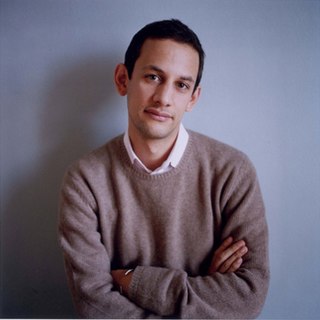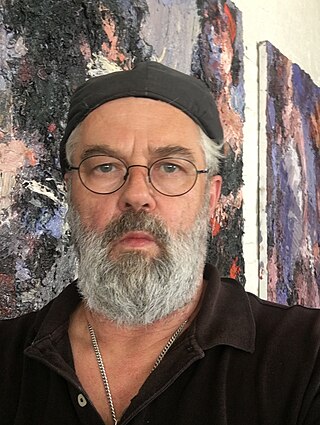
Lonnie Bradley Holley, sometimes known as the Sand Man, is an American artist, art educator, and musician. He is best known for his assemblages and immersive environments made of found materials. In 1981, after he brought a few of his sandstone carvings to then-Birmingham Museum of Art director Richard Murray, the latter helped to promote his work. In addition to solo exhibitions at the Birmingham Museum of Art and the Halsey Institute of Contemporary Art at the College of Charleston, Holley has exhibited in group exhibitions with other Black artists from the American South at the Michael C. Carlos Museum and the High Museum of Art in Atlanta, the Studio Museum in Harlem, the Metropolitan Museum of Art, the Philadelphia Museum of Art, the Toledo Museum of Art, Pérez Art Museum Miami, NSU Museum of Art Fort Lauderdale, the Institute of Contemporary Art, Boston, de Young Museum in San Francisco, National Gallery of Art, Washington, D.C., the Ikon Gallery in Birmingham, England, and the Royal Academy of Arts in London, among other places.

Jens Hoffmann Mesén is a writer, editor, educator, and exhibition maker. His work has attempted to expand the definition and context of exhibition making. From 2003 to 2007 Hoffmann was director of exhibitions at the Institute of Contemporary Arts London. He is the former director of the CCA Wattis Institute for Contemporary Art from 2007 to 2016 and deputy director for exhibitions and programs at The Jewish Museum from 2012 to 2017, a role from which he was terminated following an investigation into sexual harassment allegations brought forth by staff members. Hoffmann has held several teaching positions including California College of the Arts, the Nuova Accademia di Belle Arti and Goldsmiths, University of London, as well as others.

The Gibbes Museum of Art, formerly known as the Gibbes Art Gallery, is an art museum in Charleston, South Carolina. Established as the Carolina Art Association in 1858, the museum moved into a new Beaux Arts building at 135 Meeting Street, in the Charleston Historic District, in 1905. The Gibbes houses a premier collection of over 10,000 works of fine art, principally American works, many with a connection to Charleston or the South.
Elizabeth O'Neill Verner was an artist, author, lecturer, and preservationist who was one of the leaders of the Charleston Renaissance. She has been called "the best-known woman artist of South Carolina of the twentieth century."
Renée Stout is an American sculptor and contemporary artist known for assemblage artworks dealing with her personal history and African-American heritage. Born in Kansas, raised in Pittsburgh, living in Washington, D.C., and connected through her art to New Orleans, her art reflects this interest in African diasporic culture throughout the United States. Stout was the first American artist to exhibit in the Smithsonian's National Museum of African Art.

Mark Sloan is an American artist, curator, author, and museum director.
Pedro Lobo is a Brazilian photographer. He currently lives in Portugal.

David Stern is a German-born American figurative painter, whose work is rooted in the European figurative art tradition and informed by American Abstract Expressionism. The main theme/motive of Stern's work is the human condition. He works almost exclusively from memory and his accumulated knowledge of the human figure. All of Stern's paintings are done with self-made mixtures of pure pigment and linseed oil. Since 2019 he has changed his practice and uses acrylic binder as a medium for his pigments.

Sonya Clark is an American artist of Afro-Caribbean heritage. Clark is a fiber artist known for using a variety of materials including human hair and combs to address race, culture, class, and history. Her beaded headdress assemblages and braided wig series of the late 1990s, which received critical acclaim, evoked African traditions of personal adornment and moved these common forms into the realm of personal and political expression. Although African art and her Caribbean background are important influences, Clark also builds on practices of assemblage and accumulation used by artists such as Betye Saar and David Hammons.
Merton Daniel Simpson was an American abstract expressionist painter and African and tribal art collector and dealer.
Jiha Moon is a contemporary artist who focuses on painting, printmaking, and sculptural ceramic objects. Born in Daegu, South Korea, Moon is currently based in Tallahassee, Florida, after years of living and working in Atlanta, Georgia. She joined Florida State University's Art department faculty in the fall of 2023.

Joyce J. Scott is an African-American artist, sculptor, quilter, performance artist, installation artist, print-maker, lecturer and educator. Named a MacArthur Fellow in 2016, and a Smithsonian Visionary Artist in 2019, Scott is best known for her figurative sculptures and jewelry using free form, off-loom beadweaving techniques, similar to a peyote stitch. Each piece is often constructed using thousands of glass seed beads or pony beads, and sometimes other found objects or materials such as glass, quilting and leather. In 2018, she was hailed for working in new medium — a mixture of soil, clay, straw, and cement — for a sculpture meant to disintegrate and return to the earth. Scott is influenced by a variety of diverse cultures, including Native American and African traditions, Mexican, Czech, and Russian beadwork, illustration and comic books, and pop culture.

William M. Halsey (1915–1999) was an influential abstract artist in the American Southeast, particularly in his home state of South Carolina. He was represented by the Bertha Schaefer Gallery in New York City (1948–53). His mural studies for the Baltimore Hebrew Congregational Temple were included in Synagogue Art Today at the Jewish Museum, New York City (1952). His work was included in the annual International Exhibition of Watercolors, the Art Institute of Chicago. He had work in the Whitney Museum's Annual Exhibition of Contemporary American Sculpture, Watercolors and Drawings (1953). A mid-career retrospective was held at the Greenville County Museum of Art in 1972 and then traveled to the Gibbes Museum of Art, Charleston, South Carolina, and the Florence Museum, Florence, South Carolina.

Jody Zellen is an American artist and educator. Her practice, consisting of digital art, painting, video art, and drawing, has been showcased by way of interactive installations, public art, and curated exhibitions. She is also known for her art criticism.
Lonnie Hutchinson is a New Zealand artist of Māori, Samoan and European descent. In 2024 Hutchinson was awarded the My ART Visual Arts Award, making an Arts Foundation Laureate.

Tanja Softić is a Bosnian-American visual artist and art educator who works in media of drawing, printmaking, painting and photography. She is Professor of Art Practice in the Department of Art and Art History at the University of Richmond.
Yu Hong is a Chinese contemporary artist. Her works characteristically portray the female perspectives in all stages of life and the relationship between the individual and the rapid social changes taking place in China. She works primarily in oil paint but also in pastels, fabric dye on canvas, silk and resin. Yu Hong is "routinely named amongst China’s leading female artists". Her work is celebrated for its intimacy, honesty and tactility.
Althea Murphy-Price is an American artist who specializes in printmaking, and Professor of Art at University of Tennessee at Knoxville. Her work "contemplates the power of hair as a signifier of cultural self-identity."
Lauren Halsey is a contemporary American artist. Halsey uses architecture and installation art to demonstrate the realities of urban neighborhoods like South Central, Los Angeles.
Aldwyth is a South Carolina artist who creates complex collages and assemblages from found materials. Her work is principally about and minutely engaged with the history of art and culture. She works "in relative seclusion from the larger art world."











